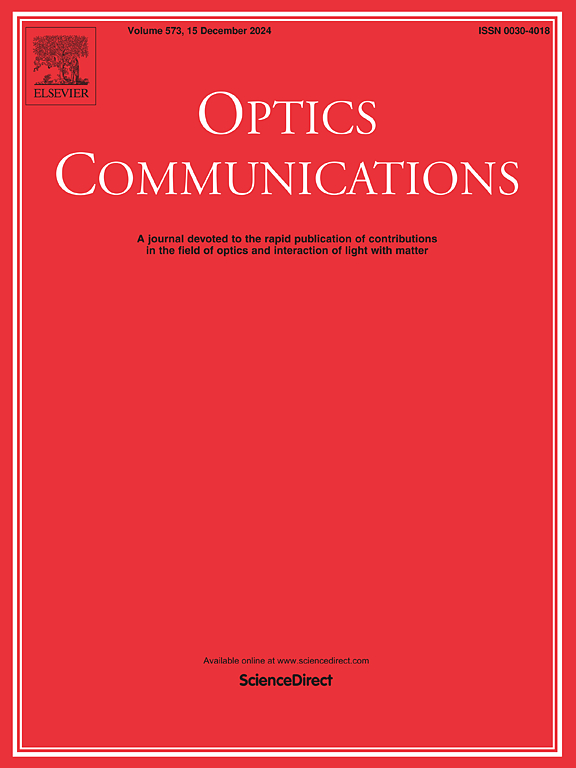在部署的光纤上使用收发器进行同步的共存时钟的Hong-Ou-Mandel干扰
IF 2.2
3区 物理与天体物理
Q2 OPTICS
引用次数: 0
摘要
独立产生的光子之间的干涉是远距离分布纠缠的关键一步,但它需要远距离光子源之间的同步。在传输量子光子信号的同一根光纤上,使用共存的双向经典光通信来同步这些光子源的时钟是实现远距离光子-光子干涉的一种很有前途的方法,可以使用部署的光纤基础设施实现量子网络的纠缠分布。在这里,我们通过观察两个距离较远的源之间的Hong-Ou-Mandel dip来证明光子-光子干涉:一个是通过衰减激光输出获得的弱相干态源,另一个是预示的单光子源。当两个光源通过4.3公里的光纤连接时,我们实现了0.58±0.04的最大倾角能见度。Dip可见度>;0.5是非经典的,是在已部署的光纤基础设施上实现隐形传输的第一步。在我们的实验中,使用−21 dBm的光信号发射功率实现经典光通信,用于同步两个独立的、距离较远的光子源中的时钟。通过适当选择量子通道和经典通道波长,可以减轻经典光信号自发拉曼散射的影响。我们实验中使用的所有设备(光子源和同步装置)都是市售的。最后,我们的实验代表了一种可扩展的方法,可以通过商用设备实现实用的量子网络,并与光纤中的经典通信共存。本文章由计算机程序翻译,如有差异,请以英文原文为准。
Hong-Ou-Mandel interference with a coexisting clock using transceivers for synchronization over deployed fiber
Interference between independently generated photons is a key step towards distributing entanglement over long distances, but it requires synchronization between the distantly-located photon sources. Synchronizing the clocks of such photon sources using coexisting two-way classical optical communications over the same fiber that transports the quantum photonic signals is a promising approach for achieving photon–photon interference over long distances, enabling entanglement distribution for quantum networking using the deployed fiber infrastructure. Here, we demonstrate photon–photon interference by observing the Hong–Ou–Mandel dip between two distantly-located sources: a weak coherent-state source obtained by attenuating the output of a laser and a heralded single-photon source. We achieve a maximum dip visibility of when the two sources are connected via 4.3 km of deployed fiber. Dip visibilities are nonclassical and a first step towards achieving teleportation over the deployed fiber infrastructure. In our experiment, the classical optical communication is achieved with dBm of optical signal launch power, which is used to synchronize the clocks in the two independent, distantly-located photon sources. The impact of spontaneous Raman scattering from the classical optical signals is mitigated by appropriate choice of the quantum- and classical-channel wavelengths. All equipment used in our experiment (the photon sources and the synchronization setup) is commercially available. Finally, our experiment represents a scalable approach to enabling practical quantum networking with commercial equipment and coexistence with classical communications in optical fiber.
求助全文
通过发布文献求助,成功后即可免费获取论文全文。
去求助
来源期刊

Optics Communications
物理-光学
CiteScore
5.10
自引率
8.30%
发文量
681
审稿时长
38 days
期刊介绍:
Optics Communications invites original and timely contributions containing new results in various fields of optics and photonics. The journal considers theoretical and experimental research in areas ranging from the fundamental properties of light to technological applications. Topics covered include classical and quantum optics, optical physics and light-matter interactions, lasers, imaging, guided-wave optics and optical information processing. Manuscripts should offer clear evidence of novelty and significance. Papers concentrating on mathematical and computational issues, with limited connection to optics, are not suitable for publication in the Journal. Similarly, small technical advances, or papers concerned only with engineering applications or issues of materials science fall outside the journal scope.
 求助内容:
求助内容: 应助结果提醒方式:
应助结果提醒方式:


